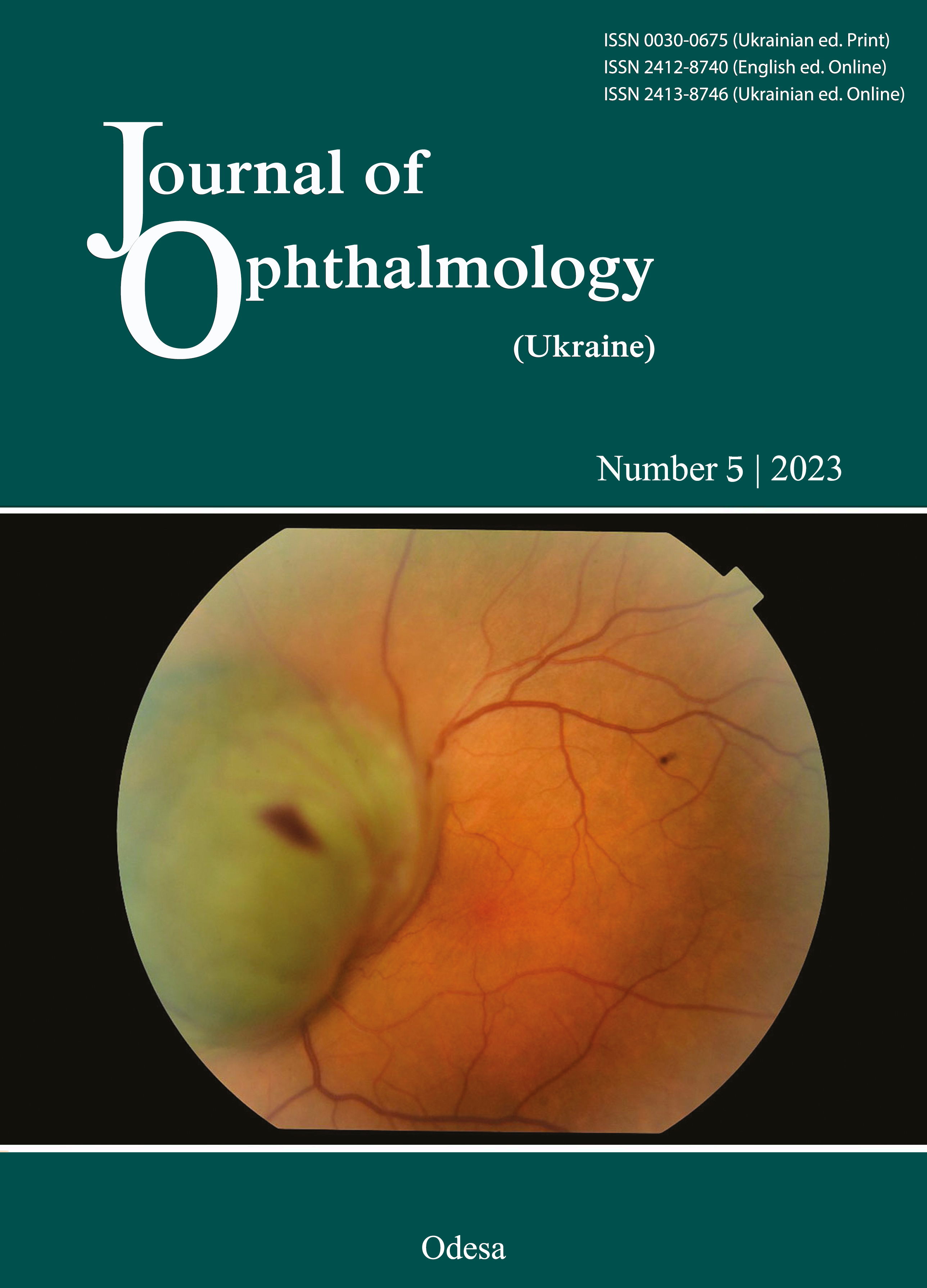Antimicrobial effects of hydrogel implants incorporating gold nanoparticles and albucide and developed for reconstructive surgery in the orbit and periorbital area
DOI:
https://doi.org/10.31288/oftalmolzh202352733Keywords:
hydrogel implants containing Au nanoparticles and albucide, antimicrobial effects, reconstructive surgery in the orbit and periorbital areaAbstract
Background: It is important to develop orbital hydrogel implants capable of depositing drugs (particularly, antimicrobial and anticancer drugs).
Purpose: To assess antimicrobial effects of hybrid hydrogel implants containing gold nanoparticles and albucide and developed for reconstructive surgery in the orbit and periorbital area.
Material and Methods: A 30% aqueous solution of albucide was used in the study. Antimicrobial activity of synthesized hydrogels was determined using Escherichia coli ATCC 25922, Enterococcus faecalis ATCC 29213, Staphylococcus aureus ATCC 25923 and Pseudomonas aeruginosa ATCC 27853 strains.
Results: All the synthesized samples of orbital hydrogel implants were sterile.
The synthesized hydrogels and hydrogel nanocomposites with incorporated Au nanoparticles demonstrated bacteriostatic effects against E. Coli ATCC 25922, E. Faecalis ATCC 29213, and S. Aureus ATCC 25923 strains, and bactericidal effects against P. Aeruginosa ATCC 27853 strain. This study also demonstrated marked bactericidal effects of hybrid hydrogel implants incorporating both Au nanoparticles and albucide.
Conclusion: Orbital hydrogel implants were found to be sterile after being sealed into polypropylene bags and steam sterilized at 121 °C for 20 minutes. Our findings of bacteriostatic and bactericidal effects of the synthesized hydrogels and hydrogel nanocomposites containing Au nanoparticles and albucide against bacterial strains of interest will allow for the absence of, or low probability of bacterial contamination in applications of these hydrogels in implants.
References
Torre LA, Bray F, Siegel RL, Ferlay J, Lortet-Tieulent J, Jemal A. Global cancer statistics, 2012. CA Cancer J Clin. 2015;65(2):87-108. https://doi.org/10.3322/caac.21262
Wicki А, Witzigmann D, Balasubramanian V, Huwyler J. Nanomedicine in cancer therapy: challenges, opportunities, and clinical applications. J Control Release. 2015;200:138-57. https://doi.org/10.1016/j.jconrel.2014.12.030
Qian Q, Shi L, Gao X, Ma Y, Yang J, Zhang Z, et al. A paclitaxel-based mucoadhesive nanogel with multivalent interactions for cervical cancer therapy. Small. 2019 Nov;15(47):e1903208. https://doi.org/10.1002/smll.201903208
Wolinsky JB, Colson YL, Grinstaff MW. Local drug delivery strategies for cancer treatment: gels, nanoparticles, polymeric films, rods, and wafers. J Control Release. 2012 Apr 10;159(1):14-26. https://doi.org/10.1016/j.jconrel.2011.11.031
Qian В, Wang Q, Shi D, Zhang L, Qian Z, Shen J, at al. A pure molecular drug hydrogel for post-surgical cancer treatment. Biomaterials. 2021 Jan;265:120403. https://doi.org/10.1016/j.biomaterials.2020.120403
Li J, Mooney DJ. Designing hydrogels for controlled drug delivery. Nat Rev Mater. 2016 Dec;1(12):16071. https://doi.org/10.1038/natrevmats.2016.71
Gundorova RA, Neroev VV, Kashnikov VV, editors. [Ocular injuries]. Moscow: GEOTAR-Media; 2009. Russian.
Krasnovid TA. [Ocular trauma under present conditions. Providing urgent care in Ukraine]. In: [Proceedings of the Conference of Ophthalmologists of Chernihiv, Kyiv, and other regions]. Chernihiv, September 12-13. 2013. pp. 40-4. Russian.
Maletskiy AP, Samchenko Iu.M, Vit VV, Bigun NM, Kernosenko LO. [Response of orbital and auricular soft tissues to the developed hydrogel implant in rabbits]. Arkhiv oftalmologii Ukrainy. 2018;6(2):20-7. Ukrainian. https://doi.org/10.22141/2309-8147.6.2.2018.172220
Samchenko IuM, Maletskiy AP, Bigun NM, Dolynskyy GA, Kernosenko LO, Pasmurtseva NO, et al. Dynamics of depositing and diffusion of drugs (chlorhexidine, 5-fluorouracil and doxorubicin) in hydrogel implants with differen thydrogel crosslinking densities. J Ophthalmol (Ukraine). 2020; 3:53-60. https://doi.org/10.31288/oftalmolzh202035360
Maletskyy A, Samchenko Yu, Bigun N. Improving the Antitumor Effect of Doxorubicin in the Treatment of Eyeball and Orbital Tumors. In: Advances in Precision Medicine Oncology, edited by Hilal Arnouk, Bassam Hassan. London: IntechOpen. 2021; 10:5772.
Bilous SB, Rieznichenko LS, Dybkova SM, Rybachuk AV, Kalyniuk TH. The studies on the pharmaceutical development of dosage forms with silver and gold nanoparticles for use in dentistry and surgery. Visnyk farmatsii. 2018; 4(96):28-36. https://doi.org/10.24959/nphj.18.2228
Kryklia S, Samchenko Y, Konovalova V, Poltoratska T, Pasmurtseva N, Ulberg Z. Hybrid pH- and thermosensitive hydrogels based on polyvinyl alcohol and acrylic monomers. Magisterium Chem Sci. 2016; 63:20-8.
Nakamoto K. Infrared and Raman Spectra of Inorganic and Coordination Compounds. John Wiley and Sons;1986.
Nakanishi K. Infrared Absorption Spectroscopy. Holden-Dey, Inc., San Francisco and Nankodo Company Limited. Tokyo;1962.
Samchenko Yu, Korotych O, Kernosenko L, Kryklia S, Litsis O, Skoryk M, et al. Stimuli-responsive hybrid porous polymers based on acetals of polyvinyl alcohol and acrylic hydrogels. Colloids Surf. A Physicochem. Eng. Asp. 2018;544:91-104. https://doi.org/10.1016/j.colsurfa.2018.02.015
Goncharuk O, Samchenko Y, Sternik D, Kernosenko L, Poltorats'ka T, Pasmurtseva A, et al. Thermosensitive hydrogel nanocomposites with magnetic laponite nanoparticles. Appl Nanosci. 2020;10:4559-4569. https://doi.org/10.1007/s13204-020-01388-w
Cerioli M, Batailler C, Conrad A, Roux S, Perpoint T, Becker A, Triffault-Fillit C, Lustig S, Fessy MH, Laurent F, Valour F, Chidiac C, Ferry T. Pseudomonasa eruginosa Implant-Associated Bone and Joint Infections: Experience in a Regional Reference Center in France. Front Med (Lausanne). 2020 Oct 26; 7:513242. https://doi.org/10.3389/fmed.2020.513242
[Cabinet of Ministers Decision No.755 of 2 October 2013 On Approval of the Technical Regulation on Implantable Active Medical Devices, as approved on 30 November, 2022. Paragraph 5]. Ukrainian.
Downloads
Published
How to Cite
Issue
Section
License
Copyright (c) 2023 Samchenko Yu. M., Dybkova S. M., Maletskyy A. P., Kernosenko L. O., Gruzina T. G., Pasmurtseva N. O., Rieznichenko L. S., Poltoratska T. P., Liutko O. B., Vitrak K. V., Bigun N. M., Vorotytskyi P. V., Mamyshev I. Ie.

This work is licensed under a Creative Commons Attribution 4.0 International License.
This work is licensed under a Creative Commons Attribution 4.0 International (CC BY 4.0) that allows users to read, download, copy, distribute, print, search, or link to the full texts of the articles, or use them for any other lawful purpose, without asking prior permission from the publisher or the author as long as they cite the source.
COPYRIGHT NOTICE
Authors who publish in this journal agree to the following terms:
- Authors hold copyright immediately after publication of their works and retain publishing rights without any restrictions.
- The copyright commencement date complies the publication date of the issue, where the article is included in.
DEPOSIT POLICY
- Authors are permitted and encouraged to post their work online (e.g., in institutional repositories or on their website) during the editorial process, as it can lead to productive exchanges, as well as earlier and greater citation of published work.
- Authors are able to enter into separate, additional contractual arrangements for the non-exclusive distribution of the journal's published version of the work with an acknowledgement of its initial publication in this journal.
- Post-print (post-refereeing manuscript version) and publisher's PDF-version self-archiving is allowed.
- Archiving the pre-print (pre-refereeing manuscript version) not allowed.












